Introduction to hard drive technology
March 12, 2007 | 10:55

SCSI vs. SATA
It is a relatively common belief that SCSI, or serial attached SCSI (SAS) in its newest incarnation, is faster than SATA for any and all situations. While this may be true for server usage patterns, and may have been true at one point for desktop applications, it no longer applies. SCSI disks are intended for use in servers and therefore the drives are tweaked specifically for that usage model.The low access times on high RPM SCSI disks sound like a great way to get a tremendous performance improvement on the desktop. However, desktop access patterns simply don’t benefit a great deal from the low seek times that 15,000 RPM drives offer. Desktop access patterns are highly localised in nature, meaning that when you’re loading up a program or game on your PC, the drive is reading most of the data from the same place on the platters.
In this situation, there is very little seeking involved. Given that most access requests are within a few MB of each other, ‘clumped’ together, a great deal of these will be serviced by data in the drive’s cache. Clever read-ahead algorithms in a drive’s firmware will assume that if your system requests a certain piece of data from a drive, it will want the data right next to it soon after, and most of the time, its right (this is why you should keep your drive well defragmented).
There are plenty of added features that running the latest SAS setup will give you, mass scalability, for instance, but none of them apply to a home computing environment.
MTBF
This is a measurement of a hard drive’s reliability that is often quite misunderstood. The MTBF, or mean time between failures, is a length of time that is achieved by monitoring failure rates for a large number of drives. For example, if drive A has a 600,000-hour MTBF and drive B has a 1.2 million-hour MTBF, don’t assume that drive A will last 68 years and drive B will last 137 years, it just isn’t going to happen.
The MTBF is attained from running a large batch of drives, sometimes hundreds sometimes thousands, and measuring how often a drive fails. Given a batch of 2,000 drives, if one fails on average every 25 days, the drive would be given an MTBF of 1.2 million hours. Unfortunately, it isn’t quite as simple as that.
It’s usually the case that the tests are accelerated by altering the conditions, for example, increasing the temperature. The end result is highly dependent on these acceleration factors being accurate. The number of drives tested is also not standardised, so manufacturers are free to increase or decrease the amount of drives to attain the ideal MTBF rating.
These factors mean that the accuracy of this figure is easily debated and a drive with a higher MTBF is not necessarily any more reliable than one with a lower MTBF. Some of the most unreliable drives in history carried a similar MTBF rating as other current drives on the market, anyone remember the infamous IBM ‘deathstar’ 60GXP and 75GXP?
Broadly speaking, the quoted MTBF of a drive dictates how its manufacturer feels about its market placement. Drive B in the above example, would be a drive intended for enterprise use, probably a SCSI/SAS drive. Its 1.2 million hour MTBF is simply the manufacturer saying “this drive is ok for 24/7 use in a data centre environment”. Drive A could be any number of desktop drives, a lower MTBF could be designated to a laptop drive.
It used to be the case that MTBF figures were quite clear-cut, most SCSI drives had the same figure and most ATA drives had the same figure. Simply put, if you had a server you used SCSI and in desktop systems you used ATA. These days, the lines between drive classes have become quite blurred. Developments in SATA mean that, performance wise, it now offers an alternative to SCSI in certain server environments, and it comes as no surprise that there are a number of SATA drives that offer enterprise-class MTBF figures to reflect this.

MSI MPG Velox 100R Chassis Review
October 14 2021 | 15:04








Want to comment? Please log in.